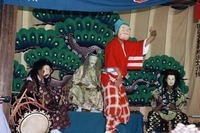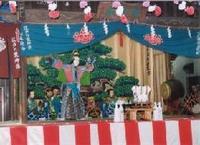

Total:35items
- Folk Performing Art (16)
- Kenbai: Sword Dance
- Kirin Shishimai: Kylin Lion Dance
- Yoshiwa Taiko Odori: Yoshiwa Drum Dance
- Omiya Odori: Omiya Dance
- Tsurusaki-Odori festival
- Omi Take-no-karakai (Tug-of-wars with bamboo)
- Nakizumo: Crying Baby Sumo
- Ryugasaki Tsukumai:Ryugasaki Acrobatic Performance
- Mikawa Manzai
- Esashi Oiwake: Esashi Folk Singing
- Ayado Yonenbutsu and Bon festival dance
- Occhi-no-Ohinagayu (rice porridge offering for the Doll's Festival in Occhi)
- Hanatori-odori Dance (Masuda area)
- Kaga-manzai
- Rice Planting festival of Tsutsukowake Shrine
- Edo sato kagura: Edo folk dance for entertaining god
- Kabuki (2)
- Noh & Kyogen (1)
- Festival (10)
- Ritual & Ceremony (2)
- Puppet Play (2)
- Folk technology (2)

 |
|
 《Feature》
《Feature》It is said that Hironobu Yamamoto, a gonritsushi (Buddhist priest) originated Edo sato kagura (performed by Yorinobu Yamamoto troupe) in 1373.
Its origin dates back to the time when villagers danced at Kuniyasu shrine in the Yamamoto family's neighborhood.
In Edomeishozukai (Guide to Famous Edo Sites, published in 1837), illustrations of Kuniyasu shrine and its temporary, shajin (lower-ranking priests) pavilions were already introduced: It is believed that this temporary pavilion was used as a prayer hall where villagers prayed and danced kagura.
There are some precious Sato kagura data preserved by Yamamoto family: Included are a manuscript (assumedly made in the middle of Edo era) of "Shinjisiki meiroku" (script) and “Iwai shrine suzumori okagurashiki" (data of kagura works, props and facial expressions created in 1769). From these data, we can learn that Sato kagura has been a popular inherited performance since Edo era and fifty works were performed in its midterm.
Currently, Yorinobu Yamomoto troupe is playing forty works and more: Most famous works are categorized into 3 types as:
[Classical]
- Ama-no-ukihashi (Bridge between the heaven and the earth)
- Yomotsu-shikome (Underworld ugly woman)
- Suminoe-no-okami (Suminoe sea-god)
- Yagumo-Shinei (Extermination legend of a huge snake)
- Ama-no-iwato (Cave of goddess)
[Modern]
- Momijigari (Autumn leaves viewing)
[Fairytale]
- Inaba-no-shirousagi (White rabbit in Inaba)
Kagura was originally an entertainment performed in ancient time, said the oldest folk performing art in the history: It was a dance dedicated to gods and comforting spirits. Possibly, it originated from the word kamukura that means "a place for gods/spirits to stay where they shall descend".
Originated in ancient era, kagura was introduced in the City of Edo and adapted into various forms by people's preference. "Edo no sato kagura" (Sato kagura of Edo) is one of them which was frequently dedicated to Edo shrine festivals and its surrounding villages. It features the dumb show based on the myth performed by masked dancers or professional kagurashi (kagura performers).
Currently, following four troupes are inheriting the tradition of Sato kagura in Tokyo: Mamiya Kazumaro (Shinagawa district), Taneo (Taito district), Gennosuke Matsumoto (Arakawa district) and Yorinobu Yamomoto (Inagi city)
[Nationally-designated important intangible folk-cultural property]
Information provided by: Lifelong Learning Department, Education Division, Inagi City Board of Education
Translation by Morito Kawaoku, reviewed by Eri Hara
| City/Town | Inagi City, Tokyo (Shinagawa, Taito and Arakawa districts)
|
|---|---|
| Location | Yorinobu Yamamoto troupe performs "Edo no Sato Kagura" in Inagi City.
Venue: 3292 Yanoguchi, Inagi city Date: Closest Sunday to Aug. 25. |
| Contact | Lifelong Learning Department, Education Division, Inagi City Board of Education
Tel: +81-42-377-2111 (Japanese Only) |
| Access | 10 minutes walk from Keio Yomiuri land station.
(Sato kagura is performed at other shrine festivals as well) |
| Highlight/POI | Dancers perform kagura in very flamboyant and elegant costumes. As they move, their costumes flutter and create the capturing spectacle combined with graceful dance. |
| URL | http://www.city.inagi.tokyo.jp/kanko/rekishi/inagishibunkazai/inagi_bunkazai/edonosatokagura.html |



